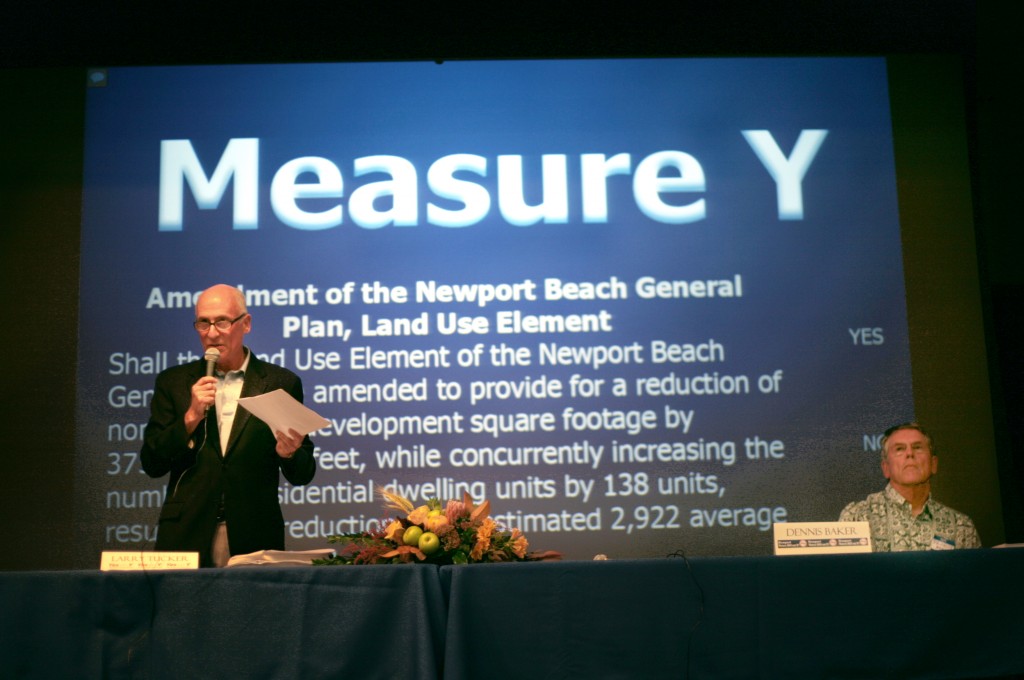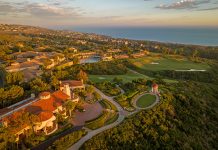
— Photo by Sara Hall ©
Newport Beach voters will head to the polls next week and have many choices to make, including a local measure regarding development, traffic and more.
Measure Y has been hotly debated over the last few months, with supporters Larry Tucker and Don Webb, and opponents Dennis Baker and Jean Watt, appearing at community meetings like Speak Up Newport and Corona del Mar Resident’s Association to discuss it.
Mayor Pro Tem Ed Selich is also a supporter and city watchdog Jim Mosher is another opponent.
“I certainly wouldn’t be promoting something that I thought would screw up my traffic or diminish my quality of life,” Selich said.
It’s a lot to take in and it can be very confusing and misleading, Baker countered. It’s a conundrum for voters, he added.
It can be confusing, Selich agreed. It helps to break it down into four main components: It retains all of the 2006 GP policies that place residents first; it adds new policies that promote environmental sustainability through such means as energy and water conservation; it eliminates any proposed changes in the airport area that would have added traffic; and it takes already authorized hotel rooms, commercial square footage and residential units from all over the city, mostly in Newport Coast, reduces all of it and places it in Newport Center.
Moving a large chuck of development from Newport Coast to Newport Center is probably the most argued point, Selich said.
Opponents completely mischaracterize the results of moving all of that square footage into Newport Center, Selich said.
It won’t clog all the intersections or create a mess, he added.
The thought that Measure Y increases traffic is a “basic flaw,” Selich said.
The current average daily trips is estimated at 790,927.
Under the current plan, in 20 years at full build-out, the total average daily trips will be 945,518.
Under what Measure Y proposes, in 20 years at full build-out, the total ADT would be 943,284.
“We’re actually reducing the amount that can be built in the future,” Selich said.
Admittedly by a small amount, he added, but still a reduction.
“I’m comparing the two plans,” Selich said, not what’s on the ground today.
“This is a general plan for the next 20 years,” Webb noted.
Traffic and development is going to continue to increase over those years. The circulation system was designed to handle that, he said.
The traffic generated by the Newport Center is a very small percentage of the overall traffic growth over the next 20 years, he said.
“A lot of things can change in 20 years,” Webb said.
As the traffic mixologist, he demonstrated with colored water to the Speak Up Newport crowd. It was a visual representation of the size of things, he said. It sounds like a lot, he said, but compared to overall picture, it’s not a lot.
The most impacted intersection is the free right turn lane on Coast Highway going west at MacArthur Boulevard, Selich said. And even there it’s only two cars per minute, he added.
That won’t make much of a difference, he said.
‘These changes in traffic are very minimal from a raw numbers standpoint,” he said.
“The traffic is what gets everybody’s attention,” Baker said. “That’s what resonates. That’s what the individual citizen, every day has to live with.”
It’s about moving traffic around to areas that can handle it better and trying to make the intersections as efficient as possible. Selich said.
They’ve taken “a little less here and a little less there” in other parts of the city in order to reduce the average daily trip number, Baker said.
Selich wrote up a 10-step analysis of “the heart of the plan.”
Step one: The already approved 1,001 hotel rooms comprising 1,060,000 square feet and 7,588 daily automobile trips eliminated; 37,825
The California Coastal Commission and the county have already approved all of that development, he said.
“Nothing is definite,” Selich said, but it’s very likely the hotel rooms will be built, it’s just a matter of when.
The city has no say over what they look like or have the ability to mitigate the impacts or obtain development agreement fees, Selich explained. There are also no height restrictions on them.
There is no reason why they wouldn’t, he added. That property, with the permits already in hand, is worth millions and millions of dollars, he added.
Although the agreement expires in 2015, The Irvine Company can ask for an extension with the county, with whom they already have a good relationship with, Selich explained.
“If Measure Y doesn’t pass, I have no doubt The Irvine Company will go to the county board of supervisors and ask them to extend the development agreement for another 20 or 25 years,” Selich said. “Anybody who thinks the county is not going to do that is pretty naïve.”
Development agreements get extended all the time, Webb added.
Step two involves eliminating the 37,825 square feet of commercial space and 356 residential units in Newport Coast, and 21,293 commercial square feet throughout the city.
Again, this property is too valuable not to use and get the most out of that space, he said.
The idea that any of this won’t be built is flawed, he said.
The numbers are incorrect, Mosher said.
Little things like deleting the six dwelling units that were accidentally added to a business in commercial zone in 2006, Mosher pointed out.
But they get counted as a reduction, he said.
“Somebody screwed up and now they’re correcting that,” Baker said.
But that’s not really an actual elimination, they argued, if they don’t exist and never will.
Both Baker and Mosher also questioned where the 356 residential units being removed from Newport Ridge.
In step three, Selich reviews adding 500 residential units, 500,000 square feet of office space and 50,000 square feet of commercial to Newport Center.
The city will be able to mitigate impacts, obtain development agreement fees and regulate the height on this development in Newport Center, whereas they would not be able to do any of that under the current plan for the development in Newport Center, Selich explained. .
Selich’s fourth step considers the traffic going through Corona del Mar.
Corona del Mar is at capacity, Webb added.
“The capacity of Coast Highway in CdM is taxed to its limits while MacArthur and Jamboree can handle the additional traffic from Newport Center,” Selich wrote in his report.
Although the hotel won’t add traffic during peak hours, it will add those trips through CdM throughout the entire day on a highway that only has four lanes, he said.
“Even if we believe their figures, that they’re about the same traffic-wise and they kind of offset each other, but at a hotel, people come in and out all during the day so the impact on us is spread out over the day. (At Newport Center) it’s all at the rush hour,” Mosher said.
It spikes at certain times and it would create more problems to add to that, Baker argued.
Moving on to Selich’s step five, he states why MacArthur and Jamboree are better equipped to handle all that traffic.
The difference is there are 12 lanes going in and out of Newport Center, he explained. Those streets are impacted less than Coast Highway would be, he said.
“We’re just pushing this traffic around,” Selich said.
The same traffic model was used for the 2006 traffic estimated in the current plan, he added.
On Selich’s step six, he noted that there will be 1,006 trips eliminated of captured internally in Newport Center by making it a mixed-use area.
“People are going to go from home to work to shop and stay in that area,” Selich said.
They won’t get out on the surrounding streets or not take their car at all and just walk or bike, depending on how close they are to their home, business or work.
“The opponents do not recognize that with mixed use development of sufficient size that overall traffic generation is reduced or will stay within Newport Center,” Selich wrote in his argument for Measure Y. “This is a proven fact and to deny it is akin to believing the earth is flat.”
It’s about creating a center of residential, office and business, Webb said. A more walkable area, he added.
In the “shuffle” of everything, one of the things being done is reducing entitlements, meaning less or restricted opportunities for businesses, Baker said.
By doing that, they’re reducing the entitlements for businesses in the neighborhoods,” like Westcliff, Eastbluff, Harbor View, etc., Baker said.
“They’re being frozen at their current size,” Mosher added.
The current limit would allow them to expand, but with this deal the current size will become the new limit and nothing new will be allowed, he said.
“What this really equates to is ‘Let’s freeze local business opportunities in the neighborhoods and let’s expand the business opportunities in Fashion Island and Newport Center,’” Baker said.
So residents who may have visited a business in their own neighborhood will have to drive to Fashion Island or Newport Center, Baker argued
There is a difference between trips going across the street and trips across town, Mosher noted. While it may be the same number of trips, the mileage and time on the road increases.
That contradicts the “sustainable community” idea, Mosher added.
In number seven Selich notes that Balboa Island trips were overstated by 3,118 trips. The traffic on the island is projected for two homes per lot when actually only a portion are two unit properties.
Selich’s eighth reason is the CdM Bypass Plan.
“The plan requires that before anything gets occupied in Newport Center that this Corona del Mar Bypass Plan be implemented,” Selich said.
The language has been changed to not be so strict, he added.
It’s going to get done, he said.
The council can still talk about the CdM Bypass Plan even if Measure Y doesn’t pass, he said, but it would definitely help the cause.
“Measure Y does two things: It provides an additional stakeholder who has a vested interest in making this happen, which is The Irvine Company,” Selich said. “The other thing is we’re going to get development agreement money, which means we’ll have the money sooner to get it done.
It also creates more certainty, he added. Otherwise, it just becomes another capital improvement project on the list, he said.
If measure Y passes, there will be money for it, it will be part of the plan and be part of the obligation on those that develop in Newport Center. The funds from the development fees, he said.
Selich’s Step nine includes working to eliminating or reducing the toll at Newport Coast Drive.
“It’s a hard battle,” Selich said, “but you can’t get anything done if you don’t try.”
On the other side, Baker said the CdM Bypass Plan would be a “great challenge” to have the Toll Road Authority give up that stretch of road.
It was added at the last minute, he noted.
Baker emphasized that the language changed from what was originally suggested, “implement” the plan, to “analyze and consider,” he explained.
“Which means nothing,” Baker said.
It has nothing to do with the amendments and any council member can ask staff to study it at any moment, Baker said.
If it read “implement” it would need to go through the California Environmental Quality Act process, Mosher explained, and would not be finished in time to be added to the measure on the November ballot.
“I don’t know what the rush is,” Mosher said. “It could be studied on it’s own.”
“The Corona del Mar Bypass is kind of a red herring,” Baker said.
It’s thrown out there to “placate” and “confuse” voters, he added.
“We’re not voting on the Corona del Mar Bypass,” Baker said.
Those developer fees would also potentially help fund all the “good stuff,” everything about sustainable communities, funding for arts, water quality, etc., is contingent on passing the measure, Baker said.
“Even though they can pass any of this they want any time,” he said. “All this good stuff… is being held hostage.”
There was no reason that prevents them from adopting all the “good stuff” and having voters only consider the major development amendments that exceed the general plan limits, Baker said.
The “good stuff” will be funded by development fees, Baker said.
“It’s all based on getting development fees,” he said. And “it’s all a maybe.”
It also depends on the skill of the council members who negotiate with the developer behind closed doors, Baker said. There is no record or transcript of the meetings either, Mosher added, so residents only now the final outcome, not the process or how the negotiation went.
“You don’t even know whether they did a good job or not,” Baker said.
“The city is addicted to developer fees,” Baker said. “The incentive is developer fees.”
The city has historically been able to extract large development fees and the council has historically been able to help pay do good things for the residents and the city, like Oasis Senior City, Marina Park, etc.
“Council members are enticed because they are good people and they want to do good things,” Baker said.
But they have no idea how much they’ll be able to get, Baker continued, or whether it will be enough or not for all the “good stuff.”
“You don’t know how much (the city will get), you don’t know who (will be doing the negotiating) and the public doesn’t get to see the process,” Baker said.
The final tenth step Selich states that there will be no change in traffic west of Jamboree Road.
Again, Selich emphasized it’s about moving traffic around to areas that can best handle it.
Voting yes will help do that, Selich said, and all of his 10 points.
But there are many problems with it, the No side argues.
The documents that the city provides residents are insufficient, confusing and omit important information , Baker argued. They provide no clarification, he added.
The city makes amendments to the general plan often, Mosher noted. The reason it’s on the ballot is because it tripped the Greenlight Initiative.
“Some of the changes are too big for the city council to make on their own,” Mosher explained.
If a development project adds more than 100 homes, significantly increases either the amount of traffic that would be generated 100 peak hour trips or the density or intensity by more than 40,000 square feet, Greenlight is activated and residents vote on the issue.
“It’s not telling you anything, anywhere that the reason it is on the ballot is because it’s exceeding these Greenlight limits,” Mosher said.
It is vaguely referred to in the city’s impartial analysis, he added, but it doesn’t tell voters exactly what exceeded the limits.
It’s because it includes 500,000 square feet of development, which is “way more” than the 40,000 limit and 500 dwelling units, which is more than the allowable 100, Mosher said.
And yet, Mosher continued, on the ballot it reads that approving it will reduce development.
“How did they come up with that?” Mosher questioned. “They extracted out of what they had adopted, not just the parts that needed voter approval, but they stuck in the parts that didn’t need voter approval where they’re lowering limits, so that they could subtract one from the other.”
“They put in enough negative stuff to offset the positive stuff so they could present it on the ballot as a reduction,” Mosher said.
Read more:
News:
Lawsuit Filed Disputing Measure Y Language
City Council Approves Revised Land Use Amendment
The following posts are **opinion columns or letters to the editor** in chronological order of publish date, most recent at top:
Do the Right Thing With Measure Y
Measure Y and a Group Think City Council
Former Mayor Weighs in on Measure Y
Transparency Needed for Measure Y
Misleading Summary on Newport Beach Ballot
Measure Y and Private Property Rights





“In the “shuffle” of everything, one of the direct things being done with “Y” is reducing entitlements, meaning less or restricted opportunities for businesses, Baker said.”
This is the heart “Y” and the clever “Corporate cronyism”, The Irvine Company is restricting the fairness of the “playing field” for the rest of City commerce. What’s happening here is one more step of TIC making Fashion Island a “City within the City”. TIC is dividing Newport Beach into an “Old Town/New Town” making Newport Center (Fashion Island) Downtown Newport Beach. Ever notice that when The old Irvine Company built Fashion Island and named it that, the new Bren TIC calls and labels it “Newport Center”, now theres your smoking gun folks! As you can see this really doesn’t have much to do with major traffic increases as Selich says…
Why didn’t the “Independent” show a link under its “Related Posts” referencing the Letter to the Editor from Susan Skinner posted in the 10/31 edition of its paper? Under its article titled “Supporters, Opponents Debate Measure Y” the paper has listed “Related Posts” which include a letter to the editor supporting Yes on Y written by Ed Selich. Ms. Skinner submitted a well written No on Y letter that repudiates the key points in the letter written by Mr. Selich. Both responses should have been included.
Hi Kathleen,
The “Related Posts” are automatically created by the website. We don’t control them. But I will manually add links to all other letters or columns we’ve published at the bottom of the story.
Sorry for the confusion.
Thanks!
Sara Hall
NB Indy